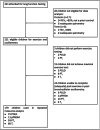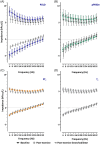Peripheral airway dysfunction in prematurity-associated obstructive lung disease identified by oscillometry
- PMID: 37701982
- PMCID: PMC10947003
- DOI: 10.1002/ppul.26658
Peripheral airway dysfunction in prematurity-associated obstructive lung disease identified by oscillometry
Abstract
Introduction: Mechanisms underlying lung dysfunction after preterm birth are poorly understood. Studying phenotypes of prematurity-associated lung disease may aid understanding of underlying mechanisms. Preterm-born children with and without lung dysfunction and term controls were assessed using oscillometry before and after exercise, and after postexercise bronchodilation.
Methods: Preterm-born children, born at gestation of 34 weeks or less, were classified into those with prematurity-associated obstructive lung disease (POLD; FEV1 < LLN, FEV1 /FVC < LLN), prematurity-associated preserved ratio of impaired spirometry (pPRISm; FEV1 < LLN, FEV1 /FVC ≥ LLN) and compared to preterm (FEV1 ≥ LLN) and term controls (%predicted FEV1 > 90%). All children underwent cardiopulmonary exercise, and oscillometry assessment at baseline, postexercise, and after postexercise bronchodilator administration.
Results: From 241 participants aged 7-12 years, complete data were available from 179: 15 children with POLD and 11 with pPRISm were compared with 93 preterm and 60 term controls. POLD group, when compared to both control groups, had impaired impedance, greater resistance, more negative (greater magnitude) reactance at low frequencies, and also had decreased compliance. pPRISm group demonstrated impaired reactance and compliance compared to term controls. No differences were noted between the preterm and term controls. Exercise had little impact on oscillometry values, but children with POLD had greatest improvements after postexercise bronchodilator administration, with decreased resistance and decreased magnitude of reactance, particularly at low frequencies.
Conclusion: Preterm-born children with obstructive airway disease had the greatest oscillometry impairments and the largest improvements after postexercise bronchodilator compared to control groups. Oscillometry can potentially be used to identify preterm-born children with lung disease to institute treatment.
Keywords: airway obstruction; albuterol; oscillometry; premature birth; respiratory mechanics.
© 2023 The Authors. Pediatric Pulmonology published by Wiley Periodicals LLC.
Conflict of interest statement
SK reports securing a research grant from the Medical Research Council for this work. SK reports funding from HTA/NIHR, Moulton Foundation, GSK, Nutricia Foundation and Aspire Pharma outside this work. BLR and ZH were supported by the Hungarian Scientific Research Fund (Grants K105403 and K128701). BLR, PDS and ZH were supported by the Clinical Research Collaboration award (The International Collaboration to Improve Respiratory Health in Children (INCIRCLE)) by the European Respiratory Society (Grant ERS CRC‐2013‐02). The other authors declare no conflicts of interest.
Figures



References
-
- Kotecha SJ, Edwards MO, Watkins WJ, et al. Effect of preterm birth on later FEV1: a systematic review and meta‐analysis. Thorax. 2013;68(8):760‐766. - PubMed
-
- Edwards MO, Kotecha SJ, Lowe J, Richards L, Watkins WJ, Kotecha S. Early‐term birth is a risk factor for wheezing in childhood: a cross‐sectional population study. J Allergy Clin Immunol. 2015;136(3):581‐587.e582. - PubMed
-
- Kotecha SJ, Dunstan FD, Kotecha S. Long term respiratory outcomes of late preterm‐born infants. Semin Fetal Neonatal Med. 2012;17(2):77‐81. - PubMed

